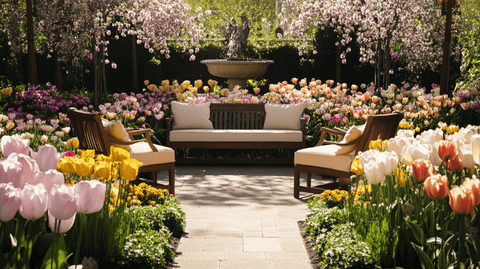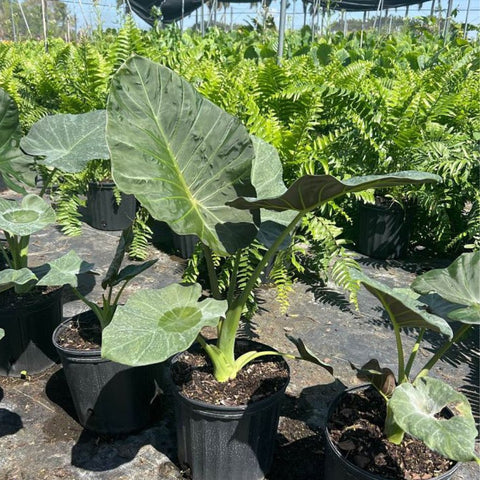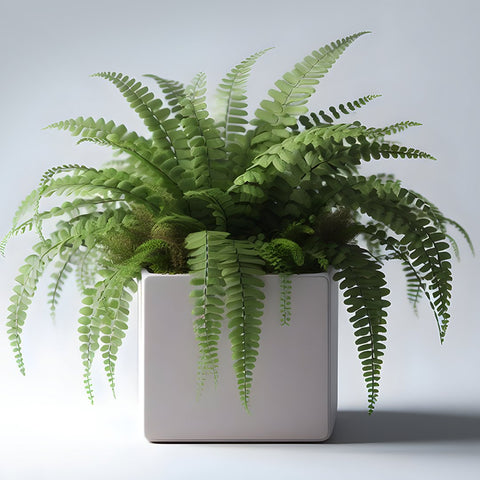I. Introduction: Embracing Spring with Blossoms
Spring is the season of renewal, a time when nature wakes up from its wintry slumber and paints the landscape with vibrant colors. Imagine stepping into your garden and being greeted by a mosaic of blooms, each exuding its unique fragrance and charm. This is the allure of a well-curated spring garden. The beauty of spring flowers is more than just visual; it’s an experience that evokes joy and a sense of rejuvenation. In this blog, we will delve into the world of popular spring garden flowers, offering both aesthetic inspiration and practical guidance for creating your own floral paradise.

Choosing the right spring flowers for your garden is crucial. These blooms don't just suggest the arrival of spring; they celebrate it in a riot of colors and forms. From delicate pastels to bold, eye-catching hues, there is a flower for every garden aficionado. But beyond beauty, these flowers hold ecological importance, supporting pollinators like bees and butterflies, thus contributing to the health of our ecosystems. As a leading e-commerce retailer, Plantology is committed to offering a wide selection of high-quality plants and trees that can transform your outdoor spaces. Let’s explore how you can make the most of this magical season with our selection of popular spring garden flowers.
II. Understanding the Spring Bloom
A. The Science of Spring Blossoms
Before we dive into specific flowers, it’s beneficial to understand what makes spring such a prolific season for flowering plants. The science of spring blossoms revolves around the interplay between temperature, sunlight, and plant biology. During winter, many plants enter a state of dormancy as a survival mechanism against the harsh conditions. As spring approaches and temperatures rise, plants sense the change in their environment.
Increased daylight is a primary trigger for many plants. The longer days signal the end of winter and the beginning of the growth phase. Light exposure affects the production of photoreceptors in plants, proteins that play a crucial role in initiating flowering. This process is called photoperiodism – it involves the plant’s ability to measure the length of day and night, determining the optimal time to flower.

The gradual warming of temperatures is another factor that affects blooming. As the ground thaws and the air warms, plants absorb essential nutrients from the soil, turning these into food energy that fuels growth and flowering. This fascinating process, all set up by nature, sets the stage for the explosion of colors we witness in springtime.
B. How Temperature and Sunlight Impact Bloom
Each flower has its own unique requirements regarding temperature and sunlight for optimal blooming. Some prefer the cooler early spring temperatures, while others require the warmth of late spring to truly flourish. Recognizing this can assist gardeners in planning a continuous bloom across the season.
Cool-season flowers like tulips and daffodils begin their bloom cycle early, taking advantage of the milder temperatures. These plants tend to be more robust, able to withstand the occasional snap of cold that might linger from winter. In contrast, flowers like azaleas and rhododendrons favor warmth and will bloom later in the spring season. Strategizing about which plants to include in your garden can enhance its visual appeal and ensure blooms from March through June.
Moreover, sunlight is a crucial partner in this botanical ballet. Full-sun plants, such as certain species of lilies and coneflowers, require at least six hours of direct sunlight a day to perform their best. Part-sun or shade-loving plants, like vinca and bleeding heart, thrive in less direct light, making them ideal for gardens with more shaded areas.
C. The Role of Soil and Hydration
Beneath the surface, unseen by most, lies a critical component of flowering success – the soil. Rich, well-draining soil can make all the difference in your garden's health. It allows roots to spread and provides essential nutrients that are crucial for plant growth. Adding organic matter, such as compost, can significantly benefit soil structure, ensuring it retains moisture while preventing waterlogging.

Watering practices, too, must adapt to the needs of different flowers. Some require constant moisture, especially right after planting, while others, like many native species, are drought-tolerant and need less frequent watering once established. By understanding these nuances, gardeners can better care for their blooms, ensuring a thriving and vibrant display throughout spring.
III. Top Popular Spring Garden Flowers
A. Tulips: The Quintessential Spring Icon
No flower better epitomizes the arrival of spring than the tulip. With dozens of varieties ranging from Darwin hybrids to graceful lily-flowered types, tulips can add structure, color, and elegance to any garden. Their straightforward care needs and spectacular colors have made them a favorite among gardeners.
Tulips are best planted in well-draining soil where they’ll receive full sunlight. They typically bloom in early to mid-spring and can be paired with later flowering plants to extend the color show throughout the season. For gardeners new to bulbs, tulip care is relatively straightforward, offering high rewards for minimal effort.
B. Daffodils: Cheerful Heralds of Spring
With their sunny disposition and easy-growing nature, daffodils bring joy to spring gardens and landscapes. Known alternatively as narcissus, these flowers are wonderfully diverse, appearing in shades ranging from buttery yellow to creamy white and even orange and pink.
Daffodils are among the hardiest of spring flowers, known for their ability to multiply over the years, making them an economical and sustainable choice for planting. They thrive in both sun and part-shade locations, developing alluring blooms in early spring. For an eco-friendly and naturalized look, consider scattering daffodil bulbs around your garden.

C. Crocus: The First Sign of Spring
Often hailed as spring's harbinger, the crocus is usually the first to break winter’s grip, sometimes even blooming amidst snow. These low-growing plants are perfect for borders and lawns and often come in striking purple, yellow, and white hues.
Plant crocus bulbs about 3 inches deep in clusters for the best visual impact. They prefer well-drained soils and full sun to part shade, making them versatile for different garden spots. Crocuses are not only beautiful but also among the earliest nectar sources for bees coming out of hibernation.
D. Hyacinths: Fragrant Spikes of Color
Hyacinths are renowned for their strikingly fragrant blooms and dense flower spikes. Their cheerful colors range from deep blues and purples to soft pinks and whites, promising a spectacular addition to any garden palette.
Hyacinths prefer fertile, well-drained soil with plenty of sunlight. Plant them around six inches deep in the fall, and they’ll reward you with vividly-colored blooms and a sweet scent that drifts through spring gardens. They can be grown in pots if space is at a premium, yet they work beautifully as border plants or in stand-alone clumps.
E. Lilies of the Nile: Exotic Elegance
The Agapanthus, commonly known as the Lily of the Nile, offers a tropical touch with its lush clusters of blue or white flowers. These perennials are not only visually arresting, but they are also highly resilient and thrive in a range of climates.
Agapanthus requires full sun and well-drained soil. Given adequate conditions, they can reward gardeners with blooms throughout late spring and into summer. At Plantology, we offer a selection of Agapanthus [for those looking to add a touch of exotic flair to their spring garden. Check out our Agapanthus Lily of the Nile Blue, perfect for adding serene azure hues to your garden landscape](https://plantologyusa.com/products/agapanthus-lily-of-the-nile-blue).

IV. Designing a Spring Garden
A. Choosing the Right Combinations
Designing your spring garden involves more than merely picking your favorite flowers. It’s about creating an appealing tapestry where hues, textures, and heights complement each other perfectly. Selecting plants that flower at different times will ensure your garden is always brimming with color throughout the season.
Consider blending bold bloomer types like tulips and daffodils with more subtle players such as crocus and muscari. It’s also wise to choose perennial flowers like the Lily of the Nile to enhance the long-term sustainability of your garden while adding a fun contrast of form and color between blossoming seasons.
B. Adding Vertical Interest
Don't forget to utilize vertical space in your garden. While flowers like crocus weave a beautiful groundcover, taller plants such as foxgloves or even climbing roses contribute striking vertical interest. This range in height ensures that your garden has depth and captures the gaze from multiple viewpoints.
C. Caring for Your Spring Garden
Proper care and maintenance are essential for keeping your garden vibrant. Regularly deadhead spent blooms to encourage more flowering and prevent seeds from taking over precious space. Mulching will help retain moisture and suppress weeds, while feeding with a balanced fertilizer boosts plant health for more resilient, lush blooms.

V. Beyond Blooms: Garden Trees and Foliage
A. The Role of Trees in a Flower Garden
Trees can anchor a flower garden, adding stature and a different form of beauty. Ornamental varieties like cherry blossoms or dogwoods add spring blooms of their own and provide shade and visual interest year-round.
For more structural beauty, consider palms, such as the Adonidia Palm. Whether a single, double, or triple form, the [Adonidia Palm](https://plantologyusa.com/products/adonidia-palm-triple) provides elegant greenery and a tropical touch that enhances any garden space.
B. Foliage Plants for Texture and Background
Foliage is another critical component of a comprehensive garden design. Plants like the aglaonema bring lush green leaves that offer a beautiful background to brightly-colored flowers. They are ideal for shaded garden areas, adding texture and interest. Discover our [Aglaonema Silver Bay](https://plantologyusa.com/products/aglaonema-silver-bay-aglaonema-commutatum) to add elegance and resilience to your shaded garden spots.
VI. Plantology’s Spring Selection and Special Offers
A. Discovering Plantology's Online Collection
At Plantology, we take pride in offering a diverse selection of high-quality trees and plants suitable for all garden styles and preferences. Our online platform ensures that browsing our extensive inventory and receiving expert gardening advice is just a click away. Whether you're starting a new garden or enhancing an existing one, our collection of spring flowers and trees can cater to your specific needs.

B. Special Offers and Discounts
To celebrate the bloom of spring, we invite you to visit our website [Plantology](https://plantologyusa.com/) and explore our special offers on a wide selection of garden plants. This is the perfect time to revitalize your garden and embrace the beauty of spring blooms. Take advantage of our seasonal discounts and transform your outdoor space into a vibrant showcase of floral beauty.
VII. Conclusion: Transforming Your Garden into a Spring Paradise
Spring is a time of transformation and beauty, a season when your garden can bring intense joy and satisfaction. By carefully selecting and arranging the right flowers and plants, you can create a space that celebrates the natural bounty of this wonderful season. Connect with nature, support vital pollinators, and enjoy the therapeutic benefits of your blooming garden paradise.
With Plantology as your gardening partner, achieving your dream garden is within reach. Explore our offerings and take your garden to the next level this spring. Whether you're a seasoned gardener or a beginner, the journey to creating a stunning spring garden starts with the right plants and the right support. Let your garden tell the colorful story of spring with the help of Plantology.

VIII. Crafting a Wildlife-friendly Spring Garden
A. Designing for Pollinators
Creating a wildlife-friendly garden during spring involves more than just aesthetics; it is about fostering an ecosystem that invites bees, butterflies, and other beneficial pollinators. Selecting a mix of native and non-native plants that blossom at different times can provide consistent sources of nectar and pollen. For instance, incorporating flowers like lavender, sunflowers, and marigolds can attract a multitude of bee species, while plants like milkweed are essential for monarch butterflies, providing a place not only to nectar but to lay eggs.
In addition to flowers, consider planting shrubs and small trees that produce berries, such as elderberry or serviceberry. These plants are critical for supporting local birds and other wildlife, offering both shelter and nourishment throughout the year. By integrating these elements, your garden becomes a lively habitat teeming with life and activity, while enhancing pollinator populations that are crucial for environmental health.
B. Sustainable Gardening Practices
Practicing sustainability in your garden not only benefits the environment but also enhances plant vitality and resilience. Utilize organic fertilizers and pest control methods to maintain a garden that is safe for wildlife and people. Techniques such as companion planting can naturally deter pests and encourage beneficial insects. For example, planting basil near tomatoes can help repel whiteflies, while marigolds can keep mosquitoes at bay.
Consider implementing a water-wise garden design by employing rain barrels and drip irrigation to conserve water. Mulching around your plants not only suppresses weeds but also helps retain moisture, reducing the need for frequent waterings. Furthermore, composting kitchen and garden waste can create nutrient-rich soil amendments, promoting healthy plant growth while minimizing waste. These sustainable efforts accumulate over time, leading to a self-sufficient and eco-friendly garden space.

C. Providing Habitats
A spring garden rich in diversely flowering plants also offers opportunities to create inviting habitats for wildlife. Simple additions such as birdhouses, bee baths, and piles of wood or stones can attract various species. Birds rely on feeders and nesting boxes as much as native trees and bushes for food and shelter, so ensuring these are in place can enhance avian presence in your garden.
To ensure your garden is a haven for valuable species like toads and newts, consider incorporating small ponds or water features. These tiny bodies of water do not need to be elaborate — even a decorative bucket can serve as a small wildlife pond. Encourage frogs and other amphibians by adding plenty of aquatic plants and submerged stones where they can seek shade and safety. Overall, these incremental habitat enhancements create a thriving habitat not just in spring, but for the entire year.
IX. Educational Opportunities in a Spring Garden
A. Understanding Plant Relationships
A garden offers endless lessons about the relationships among plants, insects, and the wider ecosystem. Take time to observe interactions among different plant species, noting how their blooms attract particular pollinators. Engage in citizen science projects like the Great Sunflower Project or Monarch Watch by tracking pollinators and contributing data that informs scientific research.
Gardens are also apt for conducting small-scale experiments. Try planting the same species in different soil types or light conditions to study how these variables impact growth and flowering. Observing such variables firsthand underscores the importance of biodiversity and adaptive strategies plants use to thrive. Sharing these findings with family or friends can turn gardening from a hobby into a profound learning experience.

B. Incorporating Digital Learning
Technological resources like gardening apps and online plant databases can enrich your understanding of plant care and identification. Apps such as PlantSnap and PictureThis can identify plants from pictures taken with your smartphone, providing information on their care needs and ecological significance.
Additionally, virtual communities such as gardening forums, social media groups, and YouTube channels offer extensive knowledge exchanges and support. By engaging with these digital resources, gardeners can gain new perspectives and techniques, from soil health strategies to maximizing yield in small spaces, all of which contribute to a more enriching gardening experience.
X. Embracing the Therapeutic Benefits of Gardening
A. Gardening as a Mindful Activity
Gardening offers more than just physical activity; it is a mindfulness practice that can enhance mental wellbeing. The act of tending to your spring garden permits moments of silence and reflection, providing a break from the hustle and bustle of daily life. Many studies suggest that interacting with nature reduces stress, anxiety, and depression levels, making gardening not just a hobby but a path to mental health improvement.
Practicing mindfulness while tending to plants involves focusing on the sensory stimuli around you — the scent of fresh blooms, the color symphony unraveling before your eyes, the sound of leaves rustling in the breeze. Each step, from digging soil to deadheading flowers, becomes an opportunity to cultivate presence and gratitude, fostering a deeper connection with yourself and the natural world.

B. Social and Community Gardens
Joining community gardens can extend the social benefits of gardening. Such collective efforts bring together people of varied backgrounds, connected through a shared passion for plants and the environment. Community gardens offer practical benefits like shared resources and knowledge, turning what can be an isolating activity into an experience enriched by collaboration and community.
These communal spaces also serve as local food sources and platforms for organized events, workshops, and garden tours. If there’s no community garden within reach, consider starting one with the support of local government or neighborhood associations. By participating in collective gardening efforts, you contribute to community resilience and foster relationships grounded in mutual respect and support for the environment.
XI. Future Trends in Spring Gardening
A. Embracing Technology in Gardening
Innovations in gardening technology are reshaping the way we interact with our gardens. Smart horticultural devices like soil sensors, automated irrigation systems, and weather stations are becoming more accessible, allowing gardeners to optimize plant care with precision. These tools not only save water and energy but also enhance plant health by providing real-time data on specific growing conditions.
Vertical and hydroponic gardening systems are also gaining popularity, especially in urban settings where space is at a premium. These efficient growing methods allow for year-round cultivation of vegetables and herbs, reducing reliance on traditional seasonal cycles and food supply chains. As technology continues to evolve, the integration of these innovations will likely become more common, offering new solutions to age-old gardening challenges.

B. Focus on Biodiversity and Native Plants
There is a growing movement towards prioritizing biodiversity and the use of native plants in garden design. Native plants often require less maintenance and are well adapted to local climates and soils, reducing the need for chemical interventions. Emphasizing these plants can promote biodiversity by providing food and habitats for native wildlife.
Incorporating a diverse array of plant species can enhance a garden's resilience against pests and diseases while offering multiple ecological benefits. Gardeners are increasingly recognizing the importance of these efforts in combating climate change and preserving local ecosystems. By making conscious choices in plant selection, your garden becomes a testament to environmental stewardship and sustainability.
XII. Conclusion: Nurturing a Flourishing Spring Garden
The fascination with spring flowers lies not only in their beauty but in their role as harbingers of renewal, encouraging us to foster and protect the natural spaces that bring our world to life. By understanding the dynamics of flowering, choosing plants wisely, and adopting sustainable practices, your garden becomes more than an aesthetic space; it is an emblem of environmental harmony and biodiversity.

With the support of Plantology, achieving a spectacular spring garden becomes an accessible and rewarding journey. Whether you are motivated by the pursuit of beauty, the need to support local pollinators, or the desire to build community and wellbeing, the world of spring gardening offers a bounty of opportunities to embrace. Begin your gardening adventure, and let it awaken your appreciation for both the intricate world of plants and the broader ecological tapestry they form.






























Comments (0)
There are no comments for this article. Be the first one to leave a message!